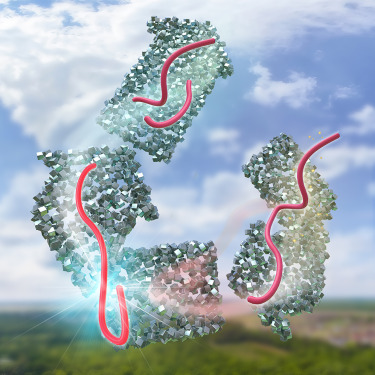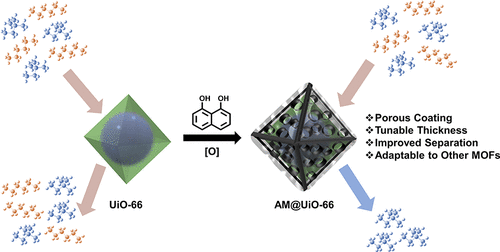
The widespread use of single-use plastics is due to their cost-effectiveness, stability, and adaptable properties. Common recycling methods like mechanical recycling and pyrolysis lack precision in turning plastic waste into uniform materials for a circular economy. Catalytic hydrogenolysis, involving breaking polymer bonds using a supported catalyst and hydrogen, holds promise for transforming plastics into valuable products for commercial use. This article highlights progress in polyolefin hydrogenolysis, specifically focusing on Pt nanoparticles on SrTiO3 nanocuboid supports. It delves into current advancements, challenges, and future directions in this field. Matter 6, 1 (2023)
|
|
Spin-Frustrated Trisradical Trication of PrismCage (Stoddart/Wasielewski)
 A new type of organic trisradical, which has threefold symmetry, has garnered attention due to its unique magnetic properties linked to spin frustration. This study introduces a triangular prism-shaped organic cage termed PrismCage6+ and its trisradical trication TR3(•+). PrismCage6+ consists of three 4,4'-bipyridinium dications and two 1,3,5-phenylene units connected by six methylene groups. The solid-state structure of PrismCage6+ shows a twisted shape with near C3 symmetry, attributed to encapsulating a PF6– anion. PrismCage6+ is progressively reduced to its mono-, di-, and trisradical cations in MeCN due to strong electronic interaction between its bipyridinium units. TR3(•+), formed by reducing PrismCage6+, adopts a prism shape with nearly C2v symmetry in the solid state. Its electron paramagnetic resonance spectra suggest a doublet ground state, indicating pronounced spin frustration and potential applications in spin chemistry and organic cages. J. Am. Chem.Soc. 145, 13195 (2023) A new type of organic trisradical, which has threefold symmetry, has garnered attention due to its unique magnetic properties linked to spin frustration. This study introduces a triangular prism-shaped organic cage termed PrismCage6+ and its trisradical trication TR3(•+). PrismCage6+ consists of three 4,4'-bipyridinium dications and two 1,3,5-phenylene units connected by six methylene groups. The solid-state structure of PrismCage6+ shows a twisted shape with near C3 symmetry, attributed to encapsulating a PF6– anion. PrismCage6+ is progressively reduced to its mono-, di-, and trisradical cations in MeCN due to strong electronic interaction between its bipyridinium units. TR3(•+), formed by reducing PrismCage6+, adopts a prism shape with nearly C2v symmetry in the solid state. Its electron paramagnetic resonance spectra suggest a doublet ground state, indicating pronounced spin frustration and potential applications in spin chemistry and organic cages. J. Am. Chem.Soc. 145, 13195 (2023)
|
|
Metal–Organic Frameworks with a Bioinspired Porous Polymer Coating for Sieving Separation (Farha/Gianneschi)

Researchers are exploring polymer and metal-organic framework (MOF) composites, aiming to combine polymer flexibility with MOF crystallinity. Traditional methods involve coating MOFs with polymers, enhancing surface polymer properties but reducing MOF porosity. A new approach introduces a porous synthetic allomelanin (AM) coating on the zirconium-based MOF UiO-66, which preserves MOF porosity while creating core-shell nanoparticles (AM@UiO-66). The strategy is adaptable for larger-pore MOFs, showing promise for hexane separation and storage capacity. This innovative technique holds potential for enhancing MOF-polymer composite properties. J. Am. Chem. Soc. 145, 18402 (2023)
|


 A new type of organic trisradical, which has threefold symmetry, has garnered attention due to its unique magnetic properties linked to spin frustration. This study introduces a triangular prism-shaped organic cage termed PrismCage6+ and its trisradical trication TR3(•+). PrismCage6+ consists of three 4,4'-bipyridinium dications and two 1,3,5-phenylene units connected by six methylene groups. The solid-state structure of PrismCage6+ shows a twisted shape with near C3 symmetry, attributed to encapsulating a PF6– anion. PrismCage6+ is progressively reduced to its mono-, di-, and trisradical cations in MeCN due to strong electronic interaction between its bipyridinium units. TR3(•+), formed by reducing PrismCage6+, adopts a prism shape with nearly C2v symmetry in the solid state. Its electron paramagnetic resonance spectra suggest a doublet ground state, indicating pronounced spin frustration and potential applications in spin chemistry and organic cages. J. Am. Chem.Soc. 145, 13195 (2023)
A new type of organic trisradical, which has threefold symmetry, has garnered attention due to its unique magnetic properties linked to spin frustration. This study introduces a triangular prism-shaped organic cage termed PrismCage6+ and its trisradical trication TR3(•+). PrismCage6+ consists of three 4,4'-bipyridinium dications and two 1,3,5-phenylene units connected by six methylene groups. The solid-state structure of PrismCage6+ shows a twisted shape with near C3 symmetry, attributed to encapsulating a PF6– anion. PrismCage6+ is progressively reduced to its mono-, di-, and trisradical cations in MeCN due to strong electronic interaction between its bipyridinium units. TR3(•+), formed by reducing PrismCage6+, adopts a prism shape with nearly C2v symmetry in the solid state. Its electron paramagnetic resonance spectra suggest a doublet ground state, indicating pronounced spin frustration and potential applications in spin chemistry and organic cages. J. Am. Chem.Soc. 145, 13195 (2023)